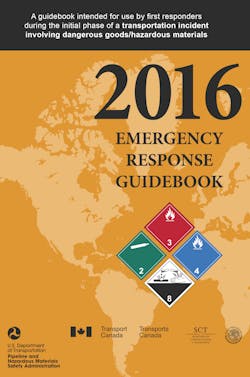The U.S. Department of Transportation (DOT) is celebrating its 50th anniversary, so it seems only fitting that an updated copy of its go-to manual for hazmat transportation incidents—the Emergency Response Guide (ERG)—was released this year. More than 1.5 million free copies of the new edition have already been provided to first responders nationwide.
From the DOT
Earlier this year, I spoke with DOT Chief of Outreach and Training Tom Kiddy from the Pipeline and Hazardous Materials Safety Administration (PHMSA) about the latest edition of ERG. In terms of what first responders should know about this resource, Kiddy explained that the ERG is intended for use by first responders during the initial phase (the first 15–20 minutes) of a transportation incident involving hazardous materials, and that it is not intended for use during incidents at fixed facilities.
Additionally, Kiddy also urged responders to resist rushing in. Hazmat incidents are technical in nature and can be extremely dangerous. As such, it is important that first responders exercise competencies outlined by OSHA 1910.120 and NFPA standards 472 and 473, which are designed to keep them safe at the scene of a hazmat incident, while dictating their limitations in terms of training and equipment.
Making changes
Each issue of the ERG is on a four-year cycle, and work begins on the next edition soon after the current one is published. The ERG working group consists of government representatives from the United States DOT/PHMSA, Transport Canada, Secretariat of Transport and Communications in Mexico, along with a representative from Argentina's emergency response call center, CEQUIME. Comments were solicited from ERG users and stakeholders through multiple channels: an announcement in the Federal Register in September 2014; an announcement on Transport Canada's website in August 2014; and through face-to-face outreach engagements at hazmat conferences throughout the country, including the IAFC Response Teams Conference (Baltimore), Continuing Challenge (Sacramento, CA) and HOTZONE in Houston. Comments are also received through [email protected].
A number of changes have been made to the 2016 ERG to make it more useful to emergency response personnel. To start, written instructions have been replaced with a flow chart to show how to use the 2016 ERG (p. 1). At the top of the flow chart are instructions to approach the incident scene from upwind, uphill or upstream. Responders are also instructed to stay clear of all spills, vapors, fumes, smoke and potential hazards. The following warning is also shown at the top of the flow chart: "Do not use the flowchart if more than one hazardous material/dangerous good is involved. Immediately call the appropriate emergency response agency telephone number listed on the inside back cover of this guidebook."
Page 2 of the 2016 ERG is now a useful page for entering local emergency telephone numbers, and Page 3 is a Table of Contents to provide for quicker navigation through the book at the incident scene.
Following are some additional changes to the ERG:
- The Table of Placards has an expanded and updated title—Table of Markings, Labels, and Placards and Initial Response Guide to Use on Scene (p. 7–8).
- The Rail Car Identification Chart and Road Trailer Identification Chart have been expanded to two pages each (p. 10–13).
- Globally Harmonized System of Classification and Labeling of Chemicals (GHS) markings information was added to the guidebook (p. 14).
- New dangerous goods/hazardous materials have been listed in UN Recommendations on the Transport of Dangerous Goods to 19th Revised Edition (p. 14).
- Pipeline emergency response information was updated, including additional information and graphics for pipeline markers (p. 20–25).
- Two additional Guides have been added to the Orange Section—Guides 173 (p. 284–285) and 174 (p. 286–287) deal with adsorbed gases, toxic, flammable and oxidizing.
- Table 1 (p. 296–345) and Table 3 (p. 354-357) in the Green Section were updated based on new TIH data and reactivity research.
- Emergency Response Assistance Plans (ERAP) applicable in Canada information was added (p. 391).
- Four pages of terms have been added to the Glossary for quick reference (p. 376–386).
Further, five additional placards have been added to the Placard Charts (p. 8). One category has been added to the unidentified cargo or dangerous placards. This label identifies hazardous materials that are exempt from shipping requirements in small quantities and that can only be placed on cargo aircraft. Flammable placards with a white triangle on the bottom half have been added to the placard chart, which indicate a combustible liquid. A rectangular Inhalation Hazard Placard with a white background has been added to the Class 2 Poisons. In addition to the Fuel Oil Placard, two other placards have been added for elevated temperature liquids—one is the HOT placard with a white background and place for a four-digit identification number, and the other is a GHS symbol of a thermometer in a triangle with a white background and the triangle and thermometer in red. Lastly, a new radioactive label has been added with an all-white background and black lettering for fissile materials, which is material capable of sustaining a nuclear fission chain reaction.
Evolution of the ERG
The field of hazardous materials is a relatively new subject for emergency responders. DOT developed the first version of a responder guidebook in 1977. It was called the Hazardous Materials Action Guides. It was 87 pages long and contained information on 43 chemicals. During 1980, the DOT created the first version of the ERG, utilizing the format we are familiar with today. It contained 66 orange guides, a placard chart as well as numerical and alphabetical sections, although they were not yet color-coded as they are in later versions.
There have been 11 editions of the ERG to date: 1980, 1984, 1987, 1990, 1993, 1996, 2000, 2004, 2008, 2012 and 2016. By comparison, the 2016 version of the ERG contains 400 pages, and lists hundreds of chemicals. The quantity of information available to first responders for dealing with the initial stages of a hazmat incident, compared to the early books, is enormous. It is important that response personnel be trained on the use of the book and become very familiar with the book in order for it to be the greatest benefit at an incident
Initial response actions
OSHA 1910.120 and NFPA 472: Standard for Competence of Responders to Hazardous Materials/Weapons of Mass Destruction Incidents identify several responsibilities for first responders to a hazardous or weapons of mass destruction incidents. These include recognition, isolation and protection. The 2016 ERG addresses all of these first responder duties and provides resources to help carry them out.
Notification: Without being able to recognize when a hazmat incident has occurred, nothing else really matters. As such, recognition is the most important criteria when responding to any incident scene. That is why it is important to resist rushing in, as noted by Kiddy. The ERG has many resources to help in recognition, including the Placard Charts, Rail Car Charts, Road Trailer Charts, GHS Labels and Pipeline section.
Once it is determined that a hazmat incident has occurred, in general, first responders do not have the necessary training or equipment to mitigate the incident. Response personnel need to access the Yellow and Blue Guide sections of the ERG to determine a name for a hazardous material or find a generic Orange section page based upon placards, tank car, road trailer or pipeline information in the ERG. Within the ERG are several notification resources, including CHEMTREC, the National Response Center, Military Shipments, National Poison Control Center, as well as some private response companies.
Isolation: Following proper notifications, the incident scene needs to be isolated so responders and the public do not come in contact with the hazardous material. The ERG contains information on initial isolation distances in the Orange and Green Guide sections.
Protection: Finally, first responders need to protect themselves and the public from harm created by the release of a hazardous material. Protection information for responders is identified in the Orange section of the ERG. Evacuation distances to protect the public are located in the Orange and Green sections. Initial Isolation distances and evacuation distances are determined by computer modeling, and analysis of actual incidents and some distances may change from one edition of the ERG to another based on changing information from computer models and actual incidents. There are charts that address situations like when a tank may experience a BLEVE and additional evacuation distances may be necessary. The charts also contain some tactical information, such as propane behavior characteristics and the amount of water needed to cool a tank. Further, information has been added to the guidebook to help responders determine if a hazmat incident could be an act of terrorism, and provides information on terrorist agents and devices. An Improvised Explosive Device (IED) Safe Stand Off Distance Chart is provided in the book as well.
In sum
The ERG is a valuable tool to be used to identify hazardous materials and determine actions to be taken by first responders in the first 15–20 minutes of a dangerous goods/hazmat incident. While the DOT stresses that the ERG is solely for transportation incidents, there is information in the ERG that can be useful for any hazmat incident, particularly if the ERG is the only information resource available in the initial phases of an incident.
Just as first responders are limited in what they can do at the scene of a hazmat emergency by equipment and training, the ERG is limited in the amount of information it provides. The ERG was not intended to be used during the mitigation phase of the incident and, therefore, should not be used as one of the reference materials selected to determine mitigation methods.
Sidebar: Get the Guide
Free copies of the ERG are provided by the DOT to all fire, police, EMS and other emergency response organizations through a selected agency in each state. Your state agency can be determined by contacting the DOT Office of Hazardous Materials Transportation Research and Special Programs (RSPA) at (202) 366-0656. State contacts are also listed on the 2016 ERG website at http://tinyurl.com/DOT-Haz-Contacts. Copies are also available for a fee from private companies online.
An electronic copy of the 2016 ERG can be found at: http://phmsa.dot.gov/hazmat/outreach-training/erg. Additionally, PSMSA partnered with the National Library of Medicine (NLM) to provide a free smartphone version of ERG 2016 for emergency responders.
The author has developed a training course for the 2016 ERG that is available in PowerPoint CD-ROM. Also included are an instructor guide and student manual, the list of state ERG contacts, a list of private-sector sources for the response guide, a course certificate template, a final exam, and an electronic version of the ERG. For information about the Placard Hazard Chart or the ERG training course, contact Robert Burke at [email protected] or visit hazardousmateialspage.com.
About the Author

Robert Burke
Robert Burke, who is a hazardous materials and fire protection consultant and who served as a Firehouse contributing editor, is a Certified Fire Protection Specialist (CFSP), Fire Inspector II, Fire Inspector III, Fire Investigator and Hazardous Materials Specialist. He has served on state and county hazmat teams. Burke is the author of the textbooks "Hazardous Materials Chemistry for Emergency Responders," "Counter-Terrorism for Emergency Responders," "Fire Protection: Systems and Response," "Hazmat Teams Across America" and "Hazmatology: The Science of Hazardous Materials."
